|
Introduction to the Hebrew Construct Chain
When two (or more) nouns appear together (either by juxtaposition or by means of a maqqef), they are said to be in a "contruct relation" to one another. For example:

The first noun of the pair (devar or d'var) is said to be in "construct" relationship with the following noun (ish or "eesh"), which is said to be in the "absolute" state. When two nouns appear in a row like this, the relationship expressed between them is one of possession, and the first word of the pair should be translated with "of" following it (devar: word of, and ish, a man).
Grammatically, a pair of words in the construct state is considered a single unit. Phonetically, the accent shifts away from the first noun to the absolute noun, and this loss of stress causes changes in the word's vowels. For example, davar changes to d'var.
The lexical form (or dictionary definition) of a noun is always listed in the singular absolute form (for example, the word davar is listed as a masculine singular noun). However, you will need to be familiar with the construct spelling of Hebrew nouns (both in the singular and in the plural) since the construct relation is common in the Scriptures. Unfortunately, the vowel changes are hard to master; fortunately, if you have memorized the absolute form, you shouldn't have too much trouble recognizing the construct form when you see it.
When first learning a Hebrew noun, I recommend writing out a flashcard with the gender, singular form, plural form, and the construct forms on the front, with the definition on the back. You might also want to include a sentence (or Bible verse) that uses the noun in your definition. For example:
Hebrew Flashcard Example:
 |
The nouns we have learned so far are all in the absolute state. A word in the absolute state may stand alone; on the other hand, a word in the construct state never stands alone (it's always seen as the first word of the pair).
 |
Morphology: Masculine Singular Construct Forms
When a masculine singular noun is in the construct state, it may or may not undergo vowel changes.
Consider the following examples, all of which have masculine singular nouns in the construct state:

In the first example, melekh (king) does not change its vowels when it appears in the construct (melekh shalom). In the second example, however, the word davar does change its vowels (d'var). In the third example, the vowels for bayit (house) change when acting as a construct (bet), as does the last example yad (hand). (Note that the third example is made definite since the absolute noun is also definite [see below]).
Note that "a hand of a man" is not really great English; we could translate this phrase as "a man's hand" without misrepresenting the Hebrew.
There are a lot of complicated rules that help to make sense of these vowel changes, but the easiest thing to do is to simply try to memorize the construct form along with the absolute form -- or minimally to be aware that the absolute form's vowels might change when the noun appears in the construct relation (I'll have more to say about the way I remember the vowel changes below).
Morphology: Feminine Singular Construct Forms
When a feminine singular noun is in the construct state, it may or may not undergo vowel changes, but if the word ends in a Hey, it changes to Tav.

Consider the following examples, all of which are feminine singular nouns in the construct state:
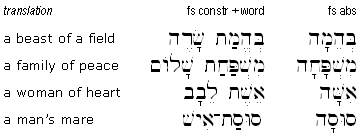
In each case above, the characteristic feminine singular noun ending (Hey-) is replaced with the Tav and the vowels have been modified in the construct forms. Note also that the last example uses a maqqef between the nouns.
Morphology: Masculine Plural Construct Forms
When a masculine plural noun is in the construct state, the ending changes to Tsere Yod and there may be vowel changes in the word.

Consider the following examples, all of which are masculine plural nouns in the construct state:

In each case above, the characteristic masculine plural noun ending is replaced with the Tsere Yod and the vowels have been modified in the construct forms. Note again that the last example uses a maqqef between the nouns.
Morphology: Feminine Plural Construct Forms
When a feminine plural noun is in the construct state, the characteristic feminine plural ending (Cholem Tav) does not change (it is a long, unchangeable vowel), though there may be vowel changes in the word.

Study the following examples, all of which are feminine plural nouns in the construct state:
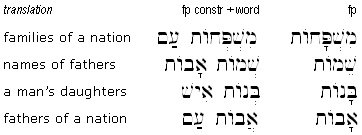
In each case above, the characteristic feminine plural noun ending is retained but the vowels have been modified in the construct forms.
Summary of the Noun Endings
The following table shows the noun endings you have learned, along with the construct form endings:

Note: Dual forms use the same endings as the Masculine Plural construct.
Definite Nouns and Construct Chains
When the second word in the pair (the absolute noun) is definite, the entire construct is considered definite (and conversely, if the second word is indefinite, the entire pair is indefinite). In other words, the "definiteness" of the entire chain is determined by the absolute noun's state. If the noun is definite (i.e., has the definite article or is a proper noun), then the chain is definite as well.
For example, the following word pair has an indefinite absolute noun (no article):
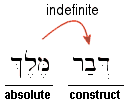
We would translate this word pair as "a word of a king."
However, if the absolute noun is made definite, we would translate it as "the word of the king":

Notice that we would not translate this pair as "the word of a king" (other constructions in Hebrew would be used for that meaning). Remember: if the absolute noun is definite, the construct noun is made definite as well.
In the next three examples, each word pair is definite since the absolute noun is a proper noun:
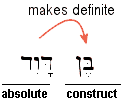
"The son of David."
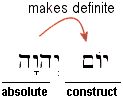
"The day of the LORD."
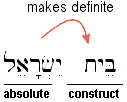
"The house of Israel."
Note: One implication of this grammatical relationship is this: A noun in the construct state never takes the definite article (i.e., whether it is definite or not depends solely on the absolute noun to which it is joined).
Irregular Construct Forms
Finally, some construct forms are "irregular" in their spelling and must simply be memorized. Here is a list of the more common ones you will encounter in the Scriptures.
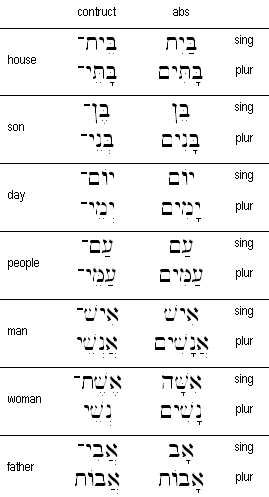
Note especially the last example. This is not a typo. You will see this irregular form also appear in other words (such as akh, brother).
Study Tip
When I write a vocabulary card for a Hebrew noun, I will include the four forms listed above (as well as the gender) on the front of the card, and the definition of the noun on the back. It's a bit tedious to do it that way, but it helps you master the various changes in spelling you will see when reading from the Scriptures.
Section Exercises
- Infer additional Hebrew vocabulary from the examples provided on the page. Use your Hebrew dictionary and write out a new flashcard for each word.
- Memorize the basic rules for using the construct relation and how the construct form appears for various nouns you know.
- Memorize the noun endings chart that includes the construct endings.
<< Return
|



















